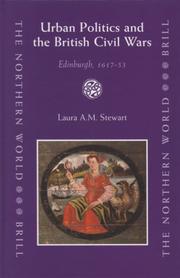| Listing 1 - 4 of 4 |
Sort by
|

ISBN: 1281399388 9786611399382 9047409760 9789047409762 9781281399380 9004151672 9789004151673 9789047409762 6611399380 Year: 2006 Publisher: Leiden ; Boston : Brill,
Abstract | Keywords | Export | Availability | Bookmark
 Loading...
Loading...Choose an application
- Reference Manager
- EndNote
- RefWorks (Direct export to RefWorks)
On 23 July 1637, riots broke out in Edinburgh. These disturbances triggered the collapse of royal authority across the British Isles. This volume explores the political and religious culture in the Scottish capital from the reign of James VI and I to the Cromwellian occupation. It examines for the first time the importance of Edinburgh to the formation of the Scottish opposition movement and to the establishment of the revolutionary Covenanting regime. Although the primary focus is the Scottish capital, an explicitly British perspective is maintained. This is a wide-ranging study that engages in debates about early modern urban culture, the problem of multiple monarchy and the issue of post-Reformation religious radicalism.
Edinburgh (Scotland) --- Great Britain --- Scotland --- Edinburgh (Lothian) --- City and Royal Burgh of Edinburgh (Scotland) --- Dun Eideann (Scotland) --- Duneideann (Scotland) --- History --- Intellectual life --- Politics and government --- 17th century --- James VI, 1567-1625 --- Charles I, 1625-1649 --- Civil War, 1642-1649 --- Intellectual life. --- Politics and government. --- Cultural life --- Culture
Book
ISBN: 9780198718444 0198718446 Year: 2015 Publisher: Oxford : Oxford university press,
Abstract | Keywords | Export | Availability | Bookmark
 Loading...
Loading...Choose an application
- Reference Manager
- EndNote
- RefWorks (Direct export to RefWorks)
The English revolution is one of the most intensely-debated events in history; parallel events in Scotland have never attracted the same degree of interest. 'Rethinking the Scottish Revolution' argues for a new interpretation of the seventeenth-century Scottish revolution that goes beyond questions about its radicalism, and reconsiders its place within an overarching 'British' narrative.0In this volume, Laura Stewart analyses how interactions between print and manuscript polemic, crowds, and political performances enabled protestors against a Prayer Book to destroy Charles I's Scottish government. Particular attention is given to the way in which debate in Scotland was affected by the emergence of London as a major publishing centre. The subscription of the 1638 National Covenant occurred within this context and further politicized subordinate social groups that included women. Unlike in England, however, public debate was contained. A remodelled constitution revivified the institutions of civil and ecclesiastical governance, enabling Covenanted Scotland to pursue interventionist policies in Ireland and England - albeit at terrible cost to the Scottish people. 0.
Book
ISBN: 1474410162 Year: 2020 Publisher: Edinburgh : Edinburgh University Press,
Abstract | Keywords | Export | Availability | Bookmark
 Loading...
Loading...Choose an application
- Reference Manager
- EndNote
- RefWorks (Direct export to RefWorks)
A provocative new account of Scotland’s history across a century of revolution and political instability Encourages a holistic view of early modern Scotland Relates Scotland‘s political, socio-economic, and cultural development to the formation of the British imperial state, European and transatlantic migration, and the expansion of global tradePart 1 covers political developments in Scottish history between the accession of King Charles I in 1625 and the destruction of the Jacobite cause in 1745Part 2 takes a thematic approach investigating the social structures, beliefs, customs, and forms of self-representation that shaped how people understood and engaged with politicsUnion, war, conquest, revolution, attempted invasions, and armed rebellions: this was an eventful time even by the standards of Scotland’s turbulent history. At the same time, traditional notions of kinship and community came under strain as profound economic changes reshaped social relations and created new opportunities. Laura A. M. Stewart and Janay Nugent explore the creative volatility of the Anglo-Scottish relationship within a European and transatlantic context. Scotland’s integration into the burgeoning British imperial state proved easier for some than others; it also drew Scots into the global slave trade. This is a stimulating account of a contentious period, knowledge of which is crucial for an understanding of British history and the politics of today.This edition in the New History of Scotland series radically updates Rosalind Mitchison’s Lordship to Patronage (1983), covering Scotland's history, 1625-1745.
Book
ISBN: 9781474410168 1474410162 1474410170 9781474410175 9781474410182 1474410189 1474410154 Year: 2020 Publisher: Edinburgh : Edinburgh University Press,
Abstract | Keywords | Export | Availability | Bookmark
 Loading...
Loading...Choose an application
- Reference Manager
- EndNote
- RefWorks (Direct export to RefWorks)
A provocative new account of Scotland’s history across a century of revolution and political instability Encourages a holistic view of early modern Scotland Relates Scotland‘s political, socio-economic, and cultural development to the formation of the British imperial state, European and transatlantic migration, and the expansion of global tradePart 1 covers political developments in Scottish history between the accession of King Charles I in 1625 and the destruction of the Jacobite cause in 1745Part 2 takes a thematic approach investigating the social structures, beliefs, customs, and forms of self-representation that shaped how people understood and engaged with politicsUnion, war, conquest, revolution, attempted invasions, and armed rebellions: this was an eventful time even by the standards of Scotland’s turbulent history. At the same time, traditional notions of kinship and community came under strain as profound economic changes reshaped social relations and created new opportunities. Laura A. M. Stewart and Janay Nugent explore the creative volatility of the Anglo-Scottish relationship within a European and transatlantic context. Scotland’s integration into the burgeoning British imperial state proved easier for some than others; it also drew Scots into the global slave trade. This is a stimulating account of a contentious period, knowledge of which is crucial for an understanding of British history and the politics of today.This edition in the New History of Scotland series radically updates Rosalind Mitchison’s Lordship to Patronage (1983), covering Scotland's history, 1625-1745.
| Listing 1 - 4 of 4 |
Sort by
|

 Search
Search Feedback
Feedback About UniCat
About UniCat  Help
Help News
News